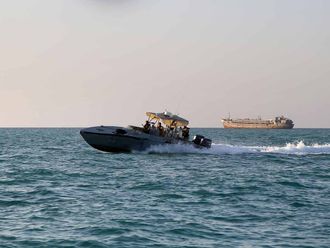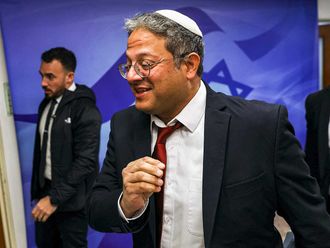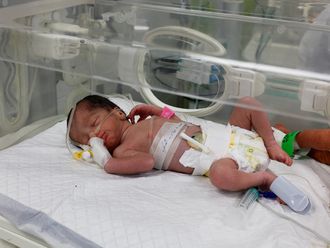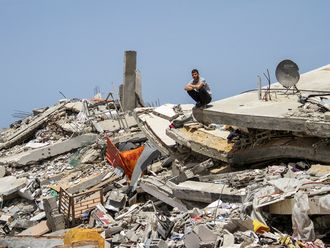
Dubai: With Syrian regime forces closing in on the opposition’s last redoubts bordering the Israeli-occupied Golan Heights, hundreds of volunteer rescue workers from the group known as the White Helmets and their family members have been evacuated through the Israeli-occupied territory and transported to Jordan. The rescue operation was carried out at the request of the US government and Western allies, according to Jordanian and Israeli regime officials.
volunteers are working with White Helmets
Jordan’s foreign minister, Ayman Safadi, said the kingdom agreed to the transfer – which was coordinated by the United Nations – after receiving assurances from Britain, Germany and Canada that the Syrians would be resettled within three months. The initial request was to receive 800 people, but only 422 made the trip Sunday, he said in a tweet. Safadi did not provide a reason. But a source familiar with the operation told the Reuters news agency that an initial plan to get out more people was hampered by Syrian regime checkpoints and the presence of forces loyal to Daesh.
Who are the White Helmets?
Founded in 2013, the White Helmets, officially known as the Syria Civil Defence, is a humanitarian organisation made up of 3,400 volunteers – former teachers, engineers, tailors and firefighters – who rush to pull people from the rubble when bombs rain down on Syrian civilians. They’ve been credited with saving thousands of civilians during the country’s continuing civil war. The group says they have saved more than 70,000 lives.
They have also exposed, through first-hand video footage, war crimes including a chemical attack in April. Their work was the subject of an Oscar-winning Netflix documentary and the recipient of two Nobel peace prize nominations. The White Helmets have offered services where state institutions and services have been non-existent. Their facilities were targeted, and their volunteers hit in what became known as “double tap” attacks that drew the volunteers to areas of bombings only to hit them once on site.
Why has only this group, and not other rescue organisations, has been provided sanctuary by the West?
The White Helmets have operated in opposition-held areas rescuing civilians from the rubble of air strikes, but they have been attacked as western agents by Russia since their work has been funded by the UK Foreign Office (FCO) and the White House. Their footage of the impact of air attacks has also shocked the western world, and revealed the often brutal impact of the Syrian air campaign. More than 250 of its volunteers have been killed in attacks.
lives have been saved by White Helmets in Syria
In April 2018 the Trump administration suspended the funding to the White Helmets as part of a wider suspension of the funding of stabilisation projects in Syria. But on June 18, the US reversed a decision to suspend funding for the White Helmets, and released about $6.6 million in aid to the group. USAID contributed at least $23 million from 2013 to March 2016. The British government provided £38.4m in aid to the White Helmets as of March 2018. The group has also received individual donations online to their Hero Fund, which provides treatment for wounded volunteers and supports their families.
Why does the Syrian regime target them?
Because of their work in opposition areas, where they were almost exclusively the only ones to offer rescue services in the face of the regime military advances, they have been considered public enemy number one by the Syrian regime.
funding provided to White Helmets by USAID from 2013 to March 2016
Despite their positive international recognition, there’s a counter-narrative pushed by a vocal network of individuals who write for alternative news sites countering the “MSM [mainstream media] agenda”. Their views align with the positions of the Syrian regime and Russia and attract an enormous online audience, amplified by high-profile alt-right personalities, appearances on Russian state TV and an army of Twitter bots.
The Syrian regime, and Russia, have called the White Helmets “terrorists,” accused them of being “agents” for foreign powers, and of cooperating with radical insurgent groups. Both Moscow and the regime have accused the White Helmets of staging rescue missions and chemical attacks to put blame on the regime.
How has the group highlighted war atrocities in Syria?
The White Helmets has documented what is taking place within the country via handheld and helmet cameras. Their footage has helped organisations like Amnesty International and the Syria Justice and Accountability Centre corroborate testimony they receive from people in Syria via phone, Skype and WhatsApp. It allows them to check the aftermath of air strikes to see whether civilians were targeted and whether there was any military presence or checkpoints. And, from the regime’s and Russia’s perspective, that’s damaging to their war narrative.
For instance, it was the White Helmets’ footage that documented the chemical attack in Khan Shaikhoun in April, which killed at least 83 people, a third of them children. UN war crimes investigators later concluded the attack was carried out by the Syrian regime against its own people. Russian state media and a network of supportive alternative news sites continue to cast doubt on investigators’ findings, describing it as “illogical” and “deliberately staged” by militants.
How did they became victims of an online propaganda machine?
The campaign to discredit the White Helmets started at the same time as Russia staged a military intervention in Syria in September 2015, supporting Bashar Al Assad’s army with air strikes bombarding opposition-held areas. Almost immediately, Russian state media such as RT and Sputnik started falsely claiming that Daesh was the only target and throwing doubt on the bombings of infrastructure and civilian sites.
volunteers killed in attacks till date
The same propaganda machine scooped up fringe anti-American activists, bloggers and researchers who believe the White Helmets are terrorists, giving them a platform on state TV and amplifying their articles through social media.
There is no evidence to suggest that these activists and bloggers were knowingly spreading disinformation, although the stories are often thinly sourced.
Scott Lucas, professor of international politics at the University of Birmingham, described the overall campaign as “agitation propaganda” in an interview with the Guardian, but said that some of its participants don’t realise they are being used as pawns.
“The most effective propaganda is when you find someone who believes it then give them support – you don’t create them from scratch,” he added.












